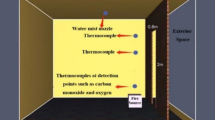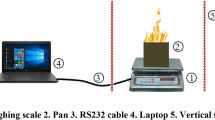Abstract
Interaction of water mist with cooking oil fires is studied experimentally and theoretically. A LDV/APV system is used to measure the velocity and diameter of water mist at different pressures in the experiments, and the effect of water mist velocity and diameter on fire extinguishment efficiency is investigated. The experimental results show that water mist has excellent surface cooling effect; it can control and extinguish cooking oil fires quickly without re-ignition. The critical temperature (Τ fo) is calculated by energy balance equation, and the fire plume momentum is calculated and compared with that of water mist in order to determine the critical velocity (ν wy) of fire extinguishment. This paper provides references for cooking oil fires extinguishment with water mist.
Similar content being viewed by others
References
Liu Z G, Andrew K, Don C, et al. Extinguishment of cooking oil fires by water mist fire suppression systems. Fire Tech, 2004, 40: 309–333
Wijayasinghe M S, Makey T B. Cooking oil: A home fire hazard in Alberta, Canada. Fire Tech, 1997, 33: 140–166
ANSUL Inc. Hybrid fire suppression technology for restaurant cooking equipment. White Paper 1015, 1999
Suh J, Atreya A. The effect of water vapor on counterflow diffusion flames. In: Proceedings of International Conference on Fire Research and Engineering, Orlando, 1995, 103–108
Koseki H, Natsume Y, Iwata Y. Combustion of high flash point materials. In: Proceedings of 7th International Fire and Materials Conference, San Francisco, 2001, 339–349
Council of Canadian Fire Marshals and Fire Commissioners. Fire Losses in Canada. Annual Report, 1997
Hui Y H. Bailey’s Industrial Edible Oil and Fat Products: Oils and Oil Seeds. 5th Ed. New York: John Wiley & Sons Inc. 1996
Edwards N. A new class of fire. Fire Prev, 1998, 310: 8–9
Voelkert C. Out of the frying pan. Fire Prev, 1998, 314: 24–26
Voelkert C. The new class K. NFPA J, 1999, 7/8
Qin J, Yao B, Chow W K. Experimental study of suppressing cooking oil fire with water mist using a cone calorimeter. Hosp Manag, 2004, 23: 545–556
Grant G, Brenton J, Drysdale D. Fire suppression by water sprays. Progr Energ Combust Sci, 2000, 26: 79–130
Kim A, Mawhinney J, Su J. Water-mist system can replace halon for use on electrical equipment. Canad Consult Eng, 1996, 5: 30–35
DiNenno J P, Beyler L C. The SFPE Handbook of Fire Protection Engineering. 2nd ed. Quincy: National Fire Protection Association, Boston: Society of Fire Protection Engineers. 1995
Anthony H, Takashi K. Characteristics of Pool Fire Burning. Gaithersburg: NIST, MD 20899
NFPA10. Standard for Portable Fire Extinguisher. Quincy: National Fire Protection Association. 1998
NFPA17. Standard for Wet Chemical Extinguishing Systems. Quincy: National Fire Protection Association. 1994
Rashbash D J. Relevance of fire point theory to the assessment of fire behaviour of combustible materials. In: Proceedings of International Symposium on Fire Safety of Combustible Materials, Edinburgh, 1975. 169–178
Author information
Authors and Affiliations
Corresponding author
About this article
Cite this article
Fang, Y., Zhang, Y., Lin, L. et al. Experimental studies on interaction of water mist with class K fires. CHINESE SCI BULL 51, 3053–3058 (2006). https://doi.org/10.1007/s11434-006-2221-y
Received:
Accepted:
Issue Date:
DOI: https://doi.org/10.1007/s11434-006-2221-y




